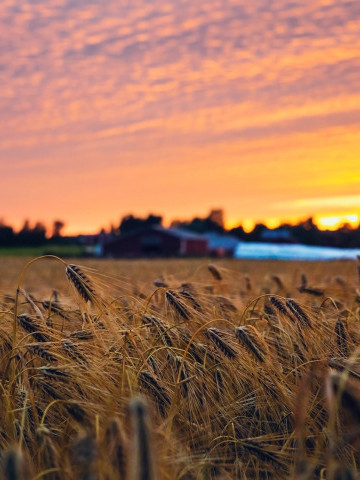
Bioekonomi
I bloggen Bioekonomi får du veta mer om Yrkeshögskolan Novias forsknings-, utvecklings- och innovationsverksamhet inom forskningsområdet systemomställning för att bygga resiliens. Majoriteten av personalen finns huvudsakligen i Raseborg. Här bildar forskare, projektarbetare, lärare, studerande och administrativ personal en dynamisk helhet. På vår blogg kan du läsa om vilka vi är, vad vi gör och om våra resultat. Välkommen!
Vid frågor eller feedback kontakta bloggens administratör Heidi Barman-Geust (Heidi.barman-geust(a)novia.fi)
Vi följer CC BY 4.0 om inget annat nämns.
Systemic Transformation to Build Resilience is one of Novia University of Applied Sciences six' research areas. The activity is mostly located in Raseborg, in southern Finland. As a dynamic unity, our researchers, project workers, teachers, students and administrative personnel produce versatile results in research, development and innovation. We blog about who we are, what we do, what our conclusions are, and how we implement them. Welcome!
If you have questions, please contact Heidi Barman (Heidi.barman-geust(a)novia.fi)
We folllow CC BY 4.0 if nothing else is stated.
Agroforestry: Seeing More than Just Trees

Ask any farmer, whether they practice agroforestry or not, and they will tell you: agroforestry is about a lot more than “just” the trees.
It is simply impossible to introduce more woody species into agricultural operations without taking into consideration how those species are going to impact the everyday, current, farming system. As the first group of farmers in the Agroforestry in Nyland (NylAF) project moves into the design phase over the winter, many of the questions will not even be about the trees themselves, but about the relationships which are going to develop between those trees and the rest of the farm system.
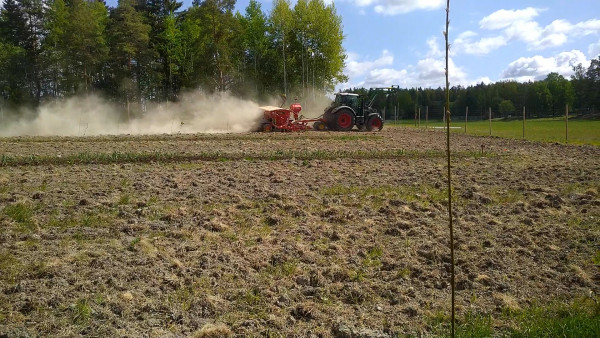 If it were not for the willow whip in the immediate foreground of this photograph, you wouldn’t even know this was an agroforestry system. The headlands (where the tractor is braking with the drill) were originally designed for smaller equipment. A 4-meter-wide drill can operate in the field with narrow headlands, but it was a little too inefficient even for a pilot project where tradeoffs can be made for the sake of more data from the tree systems. Credit: Joshua Finch, Novia UAS
If it were not for the willow whip in the immediate foreground of this photograph, you wouldn’t even know this was an agroforestry system. The headlands (where the tractor is braking with the drill) were originally designed for smaller equipment. A 4-meter-wide drill can operate in the field with narrow headlands, but it was a little too inefficient even for a pilot project where tradeoffs can be made for the sake of more data from the tree systems. Credit: Joshua Finch, Novia UASFor example, we already have questions about how to design silvopasture systems to be compatible with large scale hay making equipment. The answer of course is how you design the silvopasture system: you could easily plant a system that will make navigating the field with trees and shrubs a completely inefficient and cumbersome operation by focusing only on the trees and what they can do for the animals and pasture. You can also, through a robust analysis phase- such as the one we are conducting with each farmer- understand the current operation’s needs and make compromises which allow trees to grow on the field too. There may be less trees overall than envisioned, but a functional system is better than one that produces costly mistakes.
This is why the working definition of agroforestry we use in the project includes two very important words: “deliberate integration.” Deliberate means with consideration, integration- at its best- means that the parts work harmoniously together.
With this definition, agroforestry does not happen by accident. Sure, you can “farm with trees” without really thinking about it, and if that works for you, then by all means continue to do so. However, as farmers who have already deliberately integrated more woody species into their operations all around the world can show us, carefully designing and managing these systems leads to better outcomes. We particularly want to avoid making mistakes that could have been foreseen- with issues around compatibility with existing and potential machines (see above) used on the farm being something brought into the process from the very beginning.
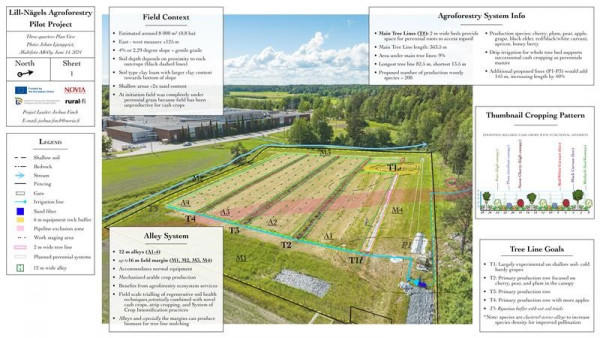 Three-quarters view of the same agroforestry site as above; the headlands (M1 & M3) were increased in size from 10 m to 16 m after deciding against adding new tree systems into the field, which would have run perpendicular to the main tree lines (the black plastic in the foreground center was beginning the process of occultation to make way for one such proposed tree system). However, we did not need relocate any trees when the headlands were increased in size because the tree lines were already purposely cut short prior to planting. Credit: Joshua Finch, Novia UAS
Three-quarters view of the same agroforestry site as above; the headlands (M1 & M3) were increased in size from 10 m to 16 m after deciding against adding new tree systems into the field, which would have run perpendicular to the main tree lines (the black plastic in the foreground center was beginning the process of occultation to make way for one such proposed tree system). However, we did not need relocate any trees when the headlands were increased in size because the tree lines were already purposely cut short prior to planting. Credit: Joshua Finch, Novia UAS
And this means that to provide information to a farmer about agroforestry, one must also be aware of how non-agroforestry farming operations work. Understanding soils, microclimates, drainage systems, planting and harvesting windows, as well as constraints around time and monetary resources are all important factors that must be considered when designing any agroforestry system.
Integration is a two way street: how will your current farming practices impact trees?
The question of what the trees will do to existing crops also has to be reversed for agroforestry to succeed: how do your current agricultural practices benefit or harm the agroforestry system you are considering? What kind of starting position is your soil in- is it even appropriate to plant trees at this juncture? If the soil is ready for your selected trees, how do your tillage, fertilization, water management, pest management, and other management practices need to change to allow the trees to thrive?
There is a lot of talk about trees in agroforestry systems absorbing excess nutrients, which is a rather interesting use of the trees, but is this even desirable from the trees’ perspective? How much excess nitrogen is moving through the landscape and what kind of impact will that have on the health of a tree? Clearly, trees need nitrogen, but will an excess of nitrogen produce weak growth prone to pests and disease? Rather than seeing one operation’s waste as a useful input for another simply because capturing runoff is a good thing to do, we also must ask direct questions about the way things are currently being done.
Would a farmer benefit from changing their current practices to ensure a better environment for trees? Is a better environment for trees also better for the current crops? If the answer to the second question is yes, then investigating agroforestry- whether it has been planted or not- can serve as a catalyst for changing practices in the present to make way for the future. In this way, agroforestry is an interesting device for helping farmers take into account externalized costs.
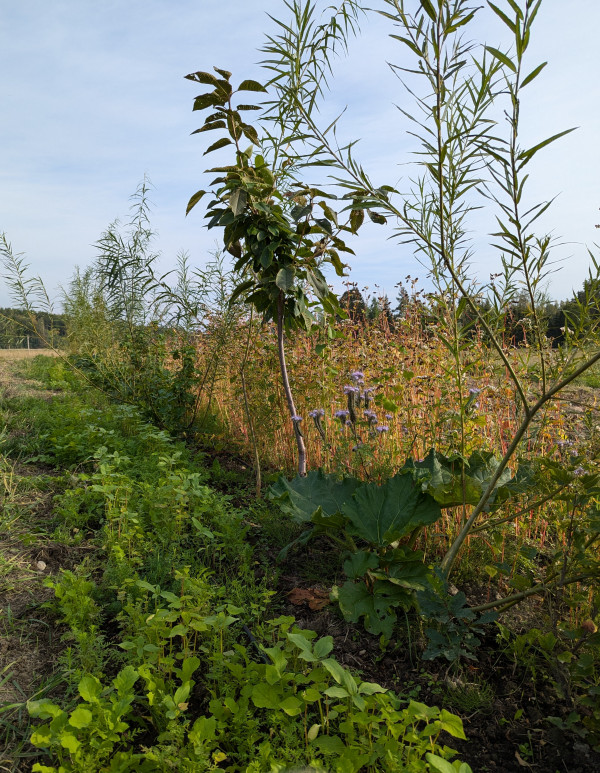
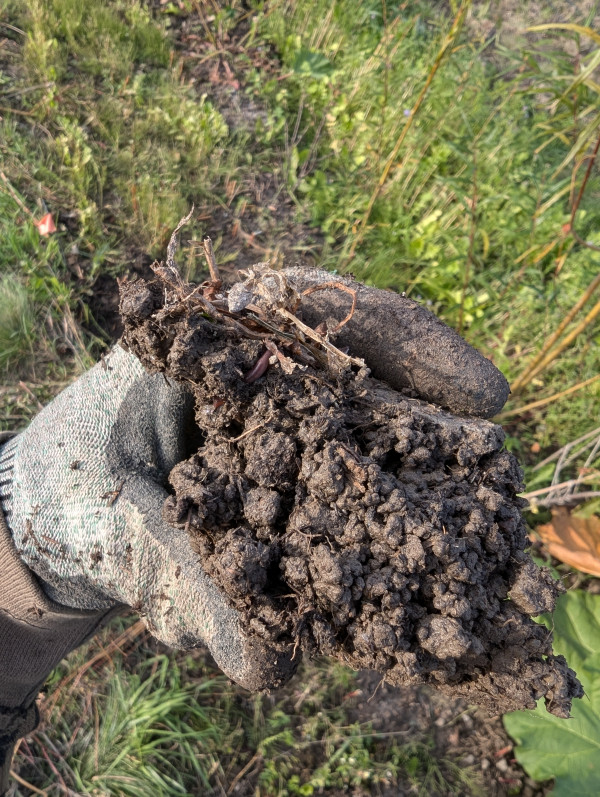 Using a suite of practices, soil is being improved for the establishment of both short and long-term cash crops. On the right is soil aggregation after just one season of primarily buckwheat cover crop (left photograph’s background, yellow/red plant) drilled into highly compacted clay loam soil which had horse manure-based compost mixed into the top ±8 cm. Credits: Joshua Finch, Novia UAS
Using a suite of practices, soil is being improved for the establishment of both short and long-term cash crops. On the right is soil aggregation after just one season of primarily buckwheat cover crop (left photograph’s background, yellow/red plant) drilled into highly compacted clay loam soil which had horse manure-based compost mixed into the top ±8 cm. Credits: Joshua Finch, Novia UASAdvancing our comprehension together through NylAF’s “Agroforestry Design Teams”
Invariably, the number of questions agroforestry design must ask is quite long, which is why our Agroforestry Design Team program structures the process and provides a roadmap towards completing a case study- a feasibility study- of the proposed systems.
I (the project manager) have some expertise with agroforestry, or at least a working knowledge of the early stages, and our farmers themselves all have varying degrees of experience and mastery of these systems. Put us together and we can answer a lot of questions, particularly if we pay attention to being deliberate in work. For questions we cannot answer meaningfully, we have resources at our disposal to hire people who can enlighten all of us.
As our project enters the first intensive design phase with the first Agroforestry Design Team, we will begin recruiting new farmers to form a second Agroforestry Design Team. This second cohort will start by observing their farms, learning more about agroforestry in general, and collecting background information in order to dive into the design stage in autumn 2025.
The blogpost has been reviewed by Novia's editorial board and accepted for publication on 23.10.2024.
Bioekonomi
Blogginlägg som är granskat av Novias redaktionsråd är utmärkta med nyckelordet "Granskat inlägg".
Vi följer CC-BY 4.0 om inget annat nämns.
Ansvarsfriskrivning: Författaren/författarna ansvarar för för fakta, möjlig utebliven information och innehållets korrekthet i bloggen. Texterna har genomgått en granskning, men de åsikter som uttrycks är författarens egna och återspeglar inte nödvändigtvis Yrkeshögskolan Novias ståndpunkter.
Disclaimer: The author(s) are responsible for the facts, any possible omissions, and the accuracy of the content in the blog.The texts have undergone a review, however, the opinions expressed are those of the author and do not necessarily reflect the views of Novia University of Applied Sciences.